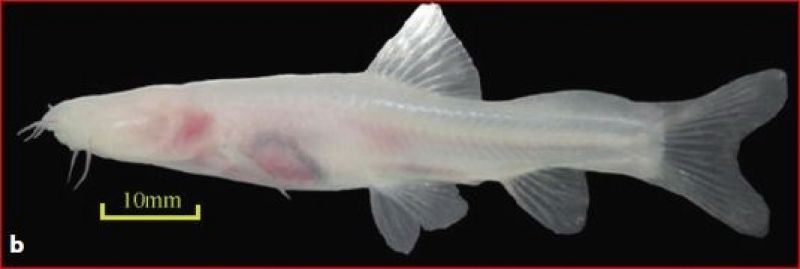Troglonectes daqikongensis
(Deng, Wen, Xiao and Zhou 2016) Huang, Yang, Wu and Zhao 2019

| ORDER | SUB-ORDER | FAMILY |
|---|---|---|
| Cypriniformes | Cobitoidei | Nemacheilidae |
Synonyms
Oreonectes daqikongensis Deng, Wen, Xiao and Zhou 2016
Country
ChinaTypes
Holotype: CNGZNU20110128001 77.14mm TL and 61.46 mm SL. Paratypes: CNGZNU20110128002–CNGZNU20110128026 (25). Zoobank registered.
Distribution
Known only from the type locailty: Yaoshui Cave, Libo County, Guizhou, China.(N 25°17'05.1", E 107°44'54.3". Altitude 488 m). See Feng et al. (2021, 2021) for details of the type locality.
Habitat
This species was found only in the Daqikong scenic area. The opening of the cave was halfway up the mountain, and the distance from the opening to the pool was about 15–20 m. The cave got no sunshine because of the twisty pathway. A large number of Hipposideros armiger lived in the cave and a thick layer of bat dung was found on the ground. Groundwater extended into the cave, and the water rushed outside the cave in the case of heavy rain. The subterranean river belonged to the Dagou river system, and was the main river of the Libo County, which runs through the whole county, enters Guangxi from the Laocun Xiang, and was the major tributary of the Duliu River system.
Systematics
The sister species of T. daqikongensis is O. shuilongensis and this pair is sister to O. platycephalus (Deng et al. 2016).
There are 19 described species in the genus Troglonectes (Eschmeyer 2022), all expect one are hypogean fishes with reduced eyes, reduced pigment and reduced scales. The only epigean member of the genus is Troglonectes hechiensis Zhao, Liu, Du and Luo 2021. The epigean species is a member of a monophyletic group which also contains T. furcocaudalis, T. daqikongensis, T. jiarongensis and T. shuilongensis (Zhao, Liu, Du and Luo 2021).
Biological Notes
The whole body of the living species is pale pink and translucent, where the vertebra, body segment at caudal peduncle, cardinal gill, and internal organs are visible. Its body color is unlikely to change when it is fed in the laboratory under light for a long term. Feng et al. (2021, 2021) describe a new species of Caridina (Decapoda: Caridea: Atyidae) from the type locality. Caridina incolor is very troglomorphic, as is the fish, and this may indicate a long-evolving troglobitic community in this cave.
Conservation Status
LC
Museum Holdings
As above only.
Internet Resources
Key References
- Waryani. B., Zhao, Y., Zhang, C., Abbasi, A.R., Ferrando, S., Dai, R., et al. (2015)
- Deng, H., Wen, H., Xiao, N. and Zhou, J. (2016)
- Huang, J.Q., Yang, J., Wu, Z.Q. and Zhao, Y.H. (2019)
- Feng, S., Chen, Q-H. and Guo, Z.-L, (2021)
- Feng, S., Chen, Q.-H. and Guo, Z.-L. (2021)
- Zhao, L.-X., Liu, J.-H., Du, L.N. and Luo, F.G. (2021)
- Zhang, E. (2024)
- Bing, H., Fang, W., He, L., Lu, Y., Xiong, Z., Xu, J. and Su, G. (2025)
| Waryani. B., Zhao, Y., Zhang, C., Abbasi, A.R., Ferrando, S., Dai, R., et al. | Journal Article | 2015 | Surface architecture of the olfactory epithelium of two Chinese cave loaches (Cypriniformes: Nemacheilidae: Oreonectes). |
| Deng, H., Wen, H., Xiao, N. and Zhou, J. | Journal Article | 2016 | A new blind species of the cave genus Oreonectes from Guizhou, China (Nemacheilidae) |
| Huang, J.Q., Yang, J., Wu, Z.Q. and Zhao, Y.H. | Journal Article | 2019 | Oreonectes guilinensis (Teleostei, Cypriniformes, Nemacheilidae), a new loach species from Guangxi, China |
| Feng, S., Chen, Q-H. and Guo, Z.-L, | Journal Article | 2021 | Utilizing integrative taxonomy uncovers a new stygobiotic Caridina species (Decapoda: Caridea: Atyidae) from Guizhou Province, China |
| Feng, S., Chen, Q.-H. and Guo, Z.-L. | Journal Article | 2021 | Integrative taxonomy uncovers a new stygobiotic Caridina species (Decapoda, Caridea, Atyidae) from Guizhou Province, China |
| Zhao, L.-X., Liu, J.-H., Du, L.N. and Luo, F.G. | Journal Article | 2021 | A new loach species of Troglonectes (Teleostei: Nemacheilidae) from Guangxi, China |
| Zhang, E. | Web Page | 2024 | Troglonectes daqikongensis. The IUCN Red List of Threatened Species 2024 |
| Bing, H., Fang, W., He, L., Lu, Y., Xiong, Z., Xu, J. and Su, G. | Journal Article | 2025 | Chromosome-level genome assembly of the obligate cave loach Troglonectes daqikongensis |